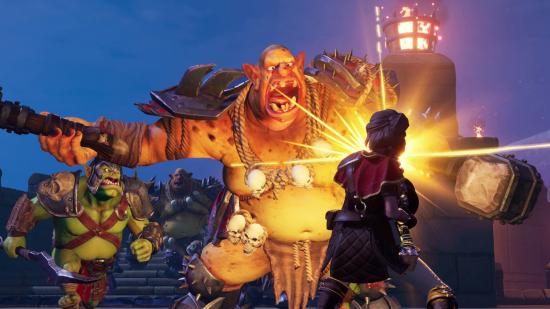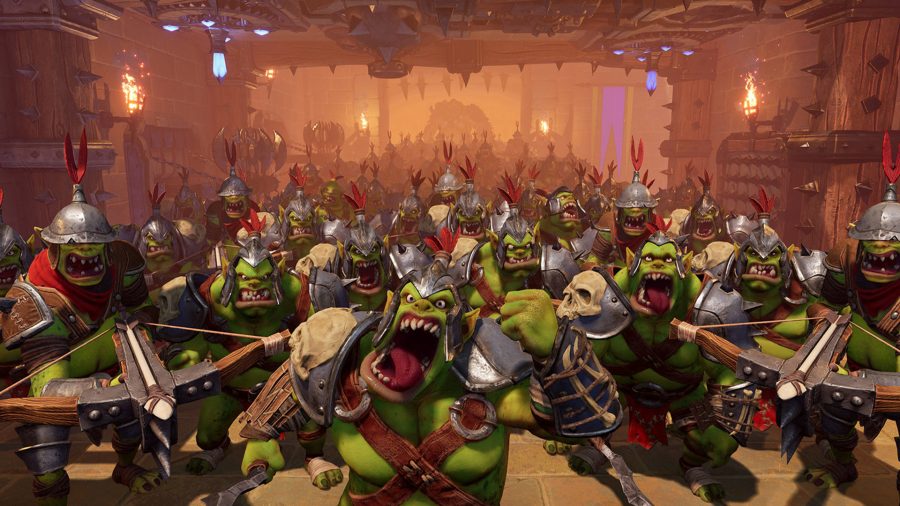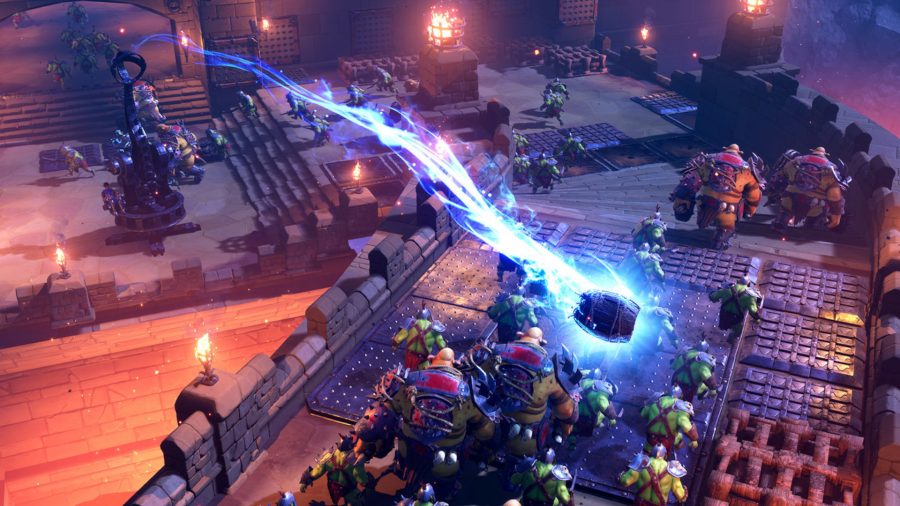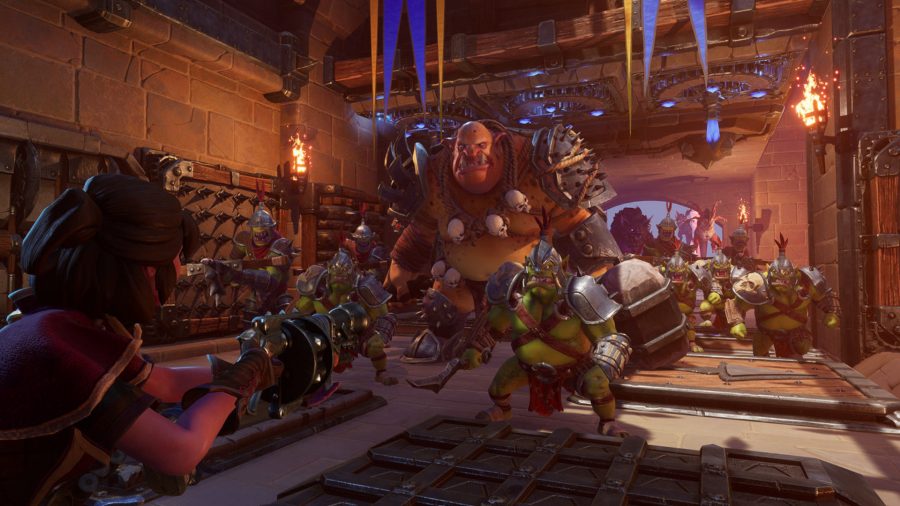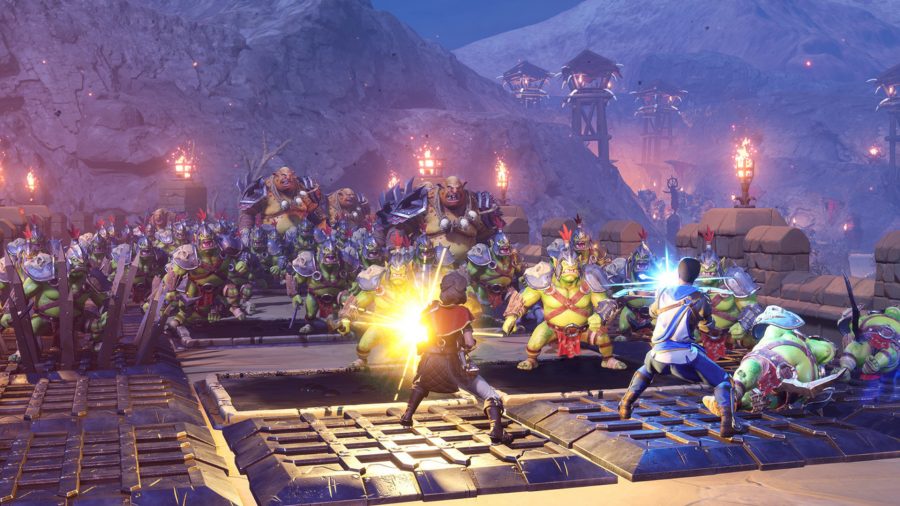Orcs Must Die 3 is finally coming, nearly a decade after the last main title in the series and following the missteps of Unchained. The third entry in the series aims to be a classic return to form, building on the original formula with a few improvements and fresh additions such as War Scenarios, which take the action to a much larger scale.
Blowing out the scale of the action-meets-tower-defense idea means some big changes to the flow of each scenario, but there’s another factor that’s looming even larger over Orcs Must Die 3’s impending release: it’s a timed Stadia exclusive, and the early response to Google’s rollout of the streaming service has been less than kind.
With all that in mind, we sat down with Jerome Jones, lead designer at Robot Entertainment, to talk about the studio’s approach to Orcs Must Die 3. Ahead of the game’s planned summer release, Jones got detailed with us about how War Scenarios work, how the game will run on Stadia, and what the studio has learned from its early success in the field of indie games.
It’s been the better part of a decade since Orcs Must Die 2 came out. How does it feel to be getting back to the series in its more traditional form?
Jerome Jones: It feels great. It’s easily Robot’s biggest franchise, and Orcs Must Die 1 and 2 had so much independent game success. We were really excited that we got this opportunity to do Orcs Must Die 3. We weren’t really planning on it at the time when we first started talking to the Google guys. We saw the tech for Stadia and all that stuff long before the discussion of Orcs Must Die 3 even came about.
There were a couple fans there at Google that were like, ‘Hey, what about Orcs Must Die 3?’ We were always excited to get back to the roots and the story of that game because it’s starting to develop into a pretty big world. We don’t want to fix something that isn’t broken – fans loved 1 and 2, and we plan on bringing them a lot of what they liked about those games.
Did you take any specific lessons from things that worked well or didn’t in the previous games?
The games did so well, and we had so much good feedback, that when you start to narrow down the things you can work on specifically and make better, it’s not that they didn’t work well but they weren’t as good as they could have been. Some of that boils down to just some of the mechanics like traps – making them better and more balanced.
I just looked at a thing yesterday where a guy took all the traps from Orcs Must Die 2, and he did a tier list on them. It was fairly accurate and it was a fair list. We’ve done a lot to try to make the balance and necessity of different traps equal. That’s one thing.
As far as the core of the game itself, it’s a pretty stable concept and it’s a pretty stable game. We’ve added some much bigger concepts to Orcs Must Die 3. But what the fans have always said about our games – separating the story people – when you get down to mechanics and scenarios and playing the game, a lot of the feedback is just ‘give us more. Give us more of what Orcs Must Die 1 and 2 did.’ That’s what we’ve tried to do, with some new, bigger features added to Orcs Must Die 3.
How do the bigger War Scenarios missions change things from the more constrained scale of the previous games?
We were calling them boss scenarios within the company. Not really because they have a boss in them, but because they’re sort of milestones, and they create these cool peaks in the campaign. As you go through the campaign, you play some regular scenarios, then you hit a War Scenario. They’re presented differently, with these big title screens, and they’re very different when you start to play them.
The biggest thing is you’re on a battlefield as opposed to being confined into four walls. You still have a fortress to defend, but there’s a big battlefield surrounding the fortress, which is completely trappable. I think it’s fair to say when you learn to play War Scenarios, it can be very intimidating. The armies are very big in a War Scenario, they come over the hill and it’s very different than a traditional Orcs Must Die scenario when you first play it.
We’ve given you the tools to beat these bigger hordes of enemies. There’s a gate now on the front of your fortress, and if you think about OMD 1 and 2, technically that gate was torn down at the beginning of every scenario, then the guys would start rushing into the fortress and you just had to defend the rift. Now you sort of have two stages – you have the battlefield outside, and you have a gate on the front of the fortress, which you can also defend. But eventually, they’re going to take down that gate, and they’re going to start making their way to the rift itself.
As we designed these levels, we thought, ‘well, we want the Horde to get through the gate by X, and then we want them to start pushing on the rift’. You have to naturally build outside on the battlefield, and the entire battlefield is trappable. You have much bigger traps, they take up a bigger space, and they kill much bigger groups of units. But as they start to threaten your gate, you have to make that transition of ‘Okay, I need to start putting traps inside the fortress now because I’m going to lose the gate.’
It’s very much like a Lord of the Rings-style fight where you’re defending the gate and the outside as long as you can. There’s some players that are so good they never lose the gate, but these are the hardcore guys at our company that are just ridiculous. But you get that feeling of falling back and having to relinquish the gate and start putting your traps inside, and defending the rift from a different perspective, as the waves progress during a War Scenario.
We had a lot of trouble – they’re very hard to balance. They were extremely hard to balance for somebody who really knows our game. For an average player, you can look at a War Scenario, and you go ‘How in the hell am I gonna do this?’ And that’s part of what I love about our game. It’s the goal, right? The goal is, after you beat any scenario, you feel like you defended against lots and lots of units, and in War Scenarios, it’s lots and lots and lots of units. So they’re pretty cool.
How do the traps change to account for the bigger environments in War Scenarios?
The war machines themselves are bigger traps. They can control bigger sets of enemies. They can kill bigger groups of enemies. They’re more expensive. You can get those to the point where they can dominate hordes and hordes of orcs. But one of the differences is that some war machines require you to be mounted inside of them. That’s a very big dynamic, because you can get very comfortable inside of this giant mega boom barrel launcher – all Orcs fans will know what a boom barrel is, and new fans will learn what a boom barrel is.
The mega boom barrel launcher is this giant catapult. It’s pretty much what you would expect: it fires this giant barrel full of cannonballs that explode. It’s a very big explosion that throws orcs 100 feet in the air, and it’s very cool. But you have to make the decision when to get out of that catapult, because you also have to fight hand-to-hand, use your weapons, and place your traps.
As for setting up traps on the battlefield, we don’t allow war machines inside the fortress, but we do allow traps that you normally set up inside, outside – that is, on the battlefield. You can still barricade the battlefield. You can put tar out there and slow things down. You can do whatever you want on the battlefield and still set up some pretty interesting mousetraps.
I don’t want to give away too much, but we have some traps that are almost like a building – you can create ceiling space, or you can create something you can get on top of out on the battlefield, and it’s all trappable. It’s pretty cool, the mousetraps you can see.
But just to sum it up: you’ve gotta deal with the battlefield, you’ve got to learn when to start transitioning inside, when you’re going to lose that gate. You’ve gotta figure out when to get out of the big traps and start placing the regular traps. It’s a sort of a peak in the campaign, and then when you beat a War Scenario, you move on to some more regular scenarios, and then you get another War Scenario. Getting to the War Scenarios can be very epic in the campaign.
How does fighting hand-to-hand factor into the bigger scale of War Scenarios?
Most of the combat in Orcs games has always been ranged, with some melee. Melee combat can be very powerful, very high damage. The downside of that huge damage is that you take more damage. When you die in Orcs Must Die, you respawn really quickly but you respawn back by the rift – which can be advantageous because things keep moving towards the rift. But it also can be a time sink if you die on the battlefield and you have to run all the way back to get back into combat mode. So melee combat is a learned ability to get better at and take advantage of that really big damage.
There’s also a lot of things you can do in combat to freeze, stun, and stone units. You can do things to make it where you’re not susceptible to damage, but it’s all in the way you build your loadout. If you want to be a melee player, you have to build a loadout that makes it easier for you to deal with taking damage or easier for you not to take damage.
The range combat is pretty much like you’d expect. It’s all skill shot. Nothing’s hitscan – you have to lead targets, and the projectiles are different speeds depending on your weapon. Some of the ranged weapons have abilities. One example of a new weapon to Orcs Must Die 3 is the chain lightning staff. The chain lightning staff can hit a lot of targets, but you have to hit that first target first. Sometimes you want to make sure you’re targeting something big, so you get the benefits of the chain, instead of trying to target something small, missing, and not getting the benefits of the chain at all.
There’s a lot of dynamics with the different weapons. I see a lot of the really high end players play a ranged weapon and a melee weapon, and they have very specific times when they go in and clean up with melee weapons, sometimes in an effort just to increase their score. Because it is a leaderboard game as well.
Does OMD3 have the same skull system for upgrades as the previous games?
Yes. You have three difficulties and you have a five skull rating. I always say in interviews that people have a hard time just one, two, three-skulling a level, even though they beat it and they’re allowed to progress through the campaign. Orcs Must Die really feeds on two things. We get a lot of stress from people complaining, ‘Oh, I can’t put a trap there. I really want to line my traps up this way.’ It feeds on your OCD, where you can line up your traps perfectly and set up the perfect mousetrap.
The other thing, when it comes to the skull system, is it sort of forces that completionist attitude. I’m not a completionist. I can live with three-skulling something and moving on. But there’s an amazing amount of people out there that really have to five-skull levels to consider themselves beating the scenarios.
And yes, it gives you more skulls for the upgrade system. The skulls are how you buy your upgrades, new weapons, new traps, and things like that, and we’ll expand on that more in the future.
Are you still able to freely respec your upgrades, as well?
We’ve actually improved on that. In the last one, when I did the respec stuff, I didn’t do it as well as I should have – I didn’t make it as free. This is a game that really encourages experimentation. We really want you to respec your traps and try different mousetraps. So now you can respec your entire spellbook, or you can respec individual traps, which makes it really friendly. You can just go ‘well, I don’t like this unique upgrade’, or ‘I don’t like spending all my skulls’, or ‘I’m not even going to use this trap this time, so I’m going to respec it and put those skulls somewhere else to play this mission’. It’s better than before.
How long is the story campaign?
I’ve been saying 12 to 15 hours for average players – middle of the road fans of Orcs Must Die. It’s gonna take them a little while to beat it. And that does not include five-skulling everything. I think the guys that want to five skull everything could be there much longer. If you just play and win regardless of your rating, and just move through the campaign, you could probably do it in about 12 to 15 hours. Then you’ve got your crazy hardcore guys who who can move through even quicker.
But besides the campaign itself, trying to five-skull everything, unlocking endless mode, and trying to beat things on Rift Lord, that’s a whole new world. When you play the game on Rift Lord, the highest difficulty, you really have to change how you think. You have to change your loadouts. You have to change your upgrades, sometimes per scenario. That whole respec allows you to do that.
It becomes quite an hour-sink for gamers. If you look back at some of our old games, there are people who register hundreds and hundreds of hours of Orcs Must Die, even though they completed the campaign in the first ten or 12 hours. But this one’s gonna be a little bit longer. War Scenarios are a little longer to play and a little longer to beat.
What additional modes are available?
The story mode is three difficulties, all with separate skull ratings. We unlock Rift Lord sooner in this game. In the old game, we didn’t unlock it until you completed the whole campaign. So now after you get a distance through the campaign, we welcome you to start trying to play Rift Lord. It’s a step up, but if you beat, say, scenario eight on Rift Lord, we’ll give you the skulls for War Mage and Apprentice. In other words, we don’t make you go back and play War Mage and Apprentice to get the skulls you would’ve got if you’d have played them once. We award them for the level you’re playing at. So if you beat something on War Mage, we give you the skulls for Apprentice. If you beat something on Rift Lord, we give you the skulls for War Mage and Apprentice. It’s much more friendly. It gets you there quicker and allows experimentation.
We have endless mode in this one. Frankly, I’m not a huge fan of endless mode, but there is this group of people out there that just love, love, love trying to see how long they can play a scenario. And if you look online, you’ll find YouTube videos of guys that have played six hours.
Then, of course, there’ll be some things in the future that I can’t talk about as we support the game – more modes and more things to do.
You’ve mentioned free and paid DLC down the line for OMD3. What’s your approach to long-term support?
One of the good things about Orcs is that the feed comes quick. We’ll get bitched at about the arrow wall or the unique upgrade on the ballista. We’ll get complaints quick, so that allows us to respond quick. A lot of supporting the game will be us taking feedback. The same goes for vanity. There’ll be some skins in the first release. And then I want to hear from people. I want to know the kinds of things people would like to see, and like to have.
We’re obviously going to think about more scenarios, and more ways for people to increase their skull counts, so they can get more upgrades and eventually own the whole spellbook. I don’t know the numbers right off-hand – I actually have them somewhere in an Excel file – but it’s quite a few hundred skulls to get to have everything at your disposal. We need to continue to give people ways to win more and more skulls, especially for the people that aren’t five-skulling everything.
Of course, the leaderboards are big in Orcs Must Die. Me and one of the designers at the office have done a lot of work to make the leaderboards less intimidating, based on where you sit in the leaderboard. In Orcs Must Die 2, frankly, I made some mistakes. Let’s say you were number 50 on the leaderboard. That guy at 49 might be four million points ahead of you, and you’re like, ‘Oh, well, I’m done. There’s no sense in me trying to move up on this leaderboard.’ The rungs of the ladder were too far apart. I’ve done a lot to do that better. I think the leaderboards are going to be a little bit less intimidating, especially with friends.
But even globally, I think you’ll see hope for moving up on the leaderboards slowly, as you get better and learn how to increase your score. Combos are a big thing in our game – killing a single orc with as many things as you can. Maybe that orc is worth ten points if you kill him with the crossbow, but if you kill him with ten things, maybe he’s worth 100 points. So combos are important to players, and that’s how players get great at moving their scores up the leaderboards.
We tried to pay a lot of attention to that, because I think the leaderboards in Orcs are a little bit more fun and enticing than some games, because you can definitely learn how to incrementally increase your score.
What are the resolution and performance targets on Stadia?
Our game renders at 4K and 60 frames per second. They use these upscaling techniques and dynamic resolution to keep the frame rates smooth when there are complex situations. Those situations can range from different things. Rendering at 4K and 60 frames has always been the goal.
Part of the beauty of Orcs Must Die is that players can create really unusual trap layouts. You can create crazy mousetraps, and you can play endless mode to wave 60. In order for wave 60 to be harder than wave 59 sometimes there’s more units. They move faster. So that can stress some things. Should those kind of things happen, we do allow the frame rate to drop a little bit in those cases, but we don’t want to limit the creativity of those players.
What are your thoughts on being such a high-profile exclusive for Stadia?
I don’t think it’s any secret – I don’t know that we would have done Orcs Must Die 3 yet. Who knows how long it would have been for us to do another Orcs game. That alone is a great reason, and a great thing about the partnership with Stadia. People really want to hear how the story progresses, and they want to play more Orcs games. That’s part of the answer.
One of the comforting things for me about Stadia is besides the stuff you see online, which is ‘Oh, I can pause the game, and I can go into the bathroom and play on my phone, and I can pause the game again. And I can go out on the back porch and play on my TV in the back in the living area outside, without ever losing progress.’ All those features are obvious, and that’s very, very cool. Frankly, it helps the dev process during the quarantine.
But one thing I think is going to be very satisfying to people who have dealt with this in their past, especially gamers who maybe don’t have as much money – they don’t have the super cool $4,000 gaming rig and the awesome monitors and the $1,100 video card. Once these War Scenarios are tuned, balanced, and running how they are supposed to run on Stadia, everybody gets that comfort of getting the same experience. Everybody gets to see this, and it has nothing to do with their computer.
You can argue forever it’s gonna have something to do with their internet connection, but internet connections in most countries are better than they are in the United States and I’m having a blast playing it. You get to experience what we expected you to experience when we when we tuned these scenarios when we made them run at these these rates and play on Stadia.
When games with huge graphics and a lot of multiplayer, or whatever the reason, came out, you saw everybody turning graphics off. ‘I’ve got to turn down my shadows, and I can’t have dynamic lighting, and I can’t have this, and I turn down polys and that’s so I can have 30 frames per second. It’s just going to be a thing of the past with cloud gaming. Hopefully this will start to show when people see the trailer and they’re like, ‘Oh my God, is my machine going to have all those orcs on the battlefield?’ It should! No reason why it shouldn’t.
In the end, we just really want the Orcs fans to realise we’re giving them what they’ve been asking for – more of Orcs. We get more of that story, and hopefully they’ll just keep having fun doing what they’ve been doing: defending the rift and using different ways to do it. And hopefully the War Scenarios and the war machines will be that added thing that’ll make them excited about continuing to mousetrap these levels and have fun playing the game.
